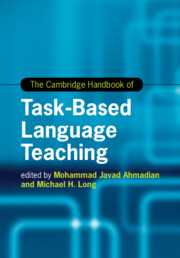Book contents
- The Cambridge Handbook of Task-Based Language Teaching
- Cambridge Handbooks In Language And Linguistics
- The Cambridge Handbook of Task-Based Language Teaching
- Copyright page
- Dedication
- Contents
- Figures
- Tables
- Contributors
- Preface The Origins and Growth of Task-Based Language Teaching
- Part I The Rationale for Task-Based Language Teaching
- Part II Tasks and Needs Analysis
- 3 Why Task? Task as a Unit of Analysis for Language Education
- 4 Adapting and Advancing Task-Based Needs Analysis Methodology across Diverse Language Learning Contexts
- 4A Developing a Task-Based Approach
- 4B A Task-Based Language Needs Analysis of Syrian Refugee Parents in Turkey
- 4C Task-Based Language Teaching in a Japanese University
- 4D The Implementation of a Task-Based Spanish-Language Program in Qingdao, China
- 5 The L in TBLT
- 5A Blustery with an Occasional Downpour
- 5B “I Have a Question”
- Part III The Task Syllabus and Materials
- Part IV Methodology and Pedagogy
- Part V Task-Based Language Teaching with School-Age Children
- Part VI The Teacher in Task-Based Language Teaching
- Part VII Task-Based Assessment and Program Evaluation
- Part VIII Research Needs and Future Prospects
- Index
- References
4D - The Implementation of a Task-Based Spanish-Language Program in Qingdao, China
A Case Study
from Part II - Tasks and Needs Analysis
Published online by Cambridge University Press: 19 November 2021
- The Cambridge Handbook of Task-Based Language Teaching
- Cambridge Handbooks In Language And Linguistics
- The Cambridge Handbook of Task-Based Language Teaching
- Copyright page
- Dedication
- Contents
- Figures
- Tables
- Contributors
- Preface The Origins and Growth of Task-Based Language Teaching
- Part I The Rationale for Task-Based Language Teaching
- Part II Tasks and Needs Analysis
- 3 Why Task? Task as a Unit of Analysis for Language Education
- 4 Adapting and Advancing Task-Based Needs Analysis Methodology across Diverse Language Learning Contexts
- 4A Developing a Task-Based Approach
- 4B A Task-Based Language Needs Analysis of Syrian Refugee Parents in Turkey
- 4C Task-Based Language Teaching in a Japanese University
- 4D The Implementation of a Task-Based Spanish-Language Program in Qingdao, China
- 5 The L in TBLT
- 5A Blustery with an Occasional Downpour
- 5B “I Have a Question”
- Part III The Task Syllabus and Materials
- Part IV Methodology and Pedagogy
- Part V Task-Based Language Teaching with School-Age Children
- Part VI The Teacher in Task-Based Language Teaching
- Part VII Task-Based Assessment and Program Evaluation
- Part VIII Research Needs and Future Prospects
- Index
- References
Summary
While a significant amount of literature has been published on the theoretical and empirical basis of task-based language teaching (TBLT) as an educational framework for teaching second and foreign languages, few studies have described entire task-based programs. This chapter reports on a case study in which we describe the inception, design, implementation and evaluation of a task-based, Spanish foreign language program at Qingdao University in China. The program is the result of an international partnership between an American university and a Chinese university, whereby Chinese students receive a dual degree in Spanish as a foreign language. A detailed needs analysis was conducted and informed the design of the program, which includes the application process, tasks, and several community-based initiatives. We also report on how we do teacher-training and professional development collaboration, our challenges, and how we have worked to overcome those challenges. All in all, teacher and student satisfaction, student job placement, and community engagement indicate that the program is meeting students’ real-world needs for Spanish and is serving the Qingdao community. We conclude by discussing implications for implementing a fully task-based program in China, the nation’s first university-level TBLT program for Spanish foreign language learning and teaching.
- Type
- Chapter
- Information
- The Cambridge Handbook of Task-Based Language Teaching , pp. 135 - 150Publisher: Cambridge University PressPrint publication year: 2021

